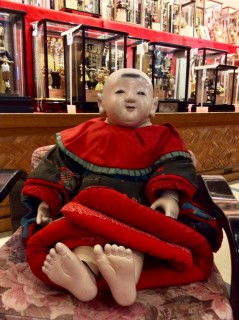Loading
Search
▼ Iwatsuki Doll History Museum
- Category:Tourism

JAPAN TRAVEL
Traditional and modern examples of the doll making art
You can meet elegant court ladies, fierce warriors, sweetly smiling babies, shrine maidens, feudal lords, entertainers, and people in period dress in Iwatsuki Ward, Saitama City which is the home to a historical Doll Town.
Iwatsuki Ward in Saitama City is a former castle town that has been the site of the doll making industry since the 17th century.
Today, the town has hundreds of shops displaying the works of local doll makers who produce charming folk art to great masterpieces of doll making.
Immediately outside Iwatsuki Station is the Togoku Doll Museum on the fourth floor of the station front building. The museum displays rare and historical dolls that document the changing styles of doll making over the centuries. The museum features imperial court dolls, hina (girl’s festival) dolls, and works by contemporary doll artisans. Admission to the museum is ¥100.
The tourist information center provides a map of various historical sites around the town, which will also leads the visitor to various doll shops.
The tourist information center provides a map of various historical sites around the town, which will also leads the visitor to various doll shops.
Hina dolls, elegantly dressed imperial court members, their attendants, and furniture, are part of the celebration of Girl’s Day, March 3rd. Boy’s Day dolls, displayed on May 5th, are typically legendary heroes and historical figures. Another common display for Boy’s Day is either a miniature suit of armor or a quiver of arrows. All of these kinds of dolls are displayed in the showrooms around Iwatsuki Station.
A 10-minute walk from the station is the Tokyu Doll Museum, headed by master doll maker, Fukuda sensei. The sprawling buildings include a showroom of boy’s and girl’s dolls, antique dolls, hagoita battledore dolls, and small items that accompany doll displays. Visitors can observe the doll making process, and by reservation, can participate in a doll making experience.
Next door, the doll museum itself documents the process of making delicate doll heads and bodies from natural products such as oyster shells, rice husks, paulownia wood and washi paper. The museum has an extensive collection of period playthings, elaborate seasonal display dolls, Edo Period miniatures, regional doll styles, and doll accessories.
By Elizabeth Scally
Next door, the doll museum itself documents the process of making delicate doll heads and bodies from natural products such as oyster shells, rice husks, paulownia wood and washi paper. The museum has an extensive collection of period playthings, elaborate seasonal display dolls, Edo Period miniatures, regional doll styles, and doll accessories.
By Elizabeth Scally
- December 12, 2017
- Comment (0)
- Trackback(0)




